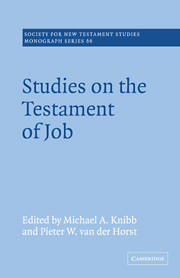Book contents
- Frontmatter
- Contents
- List of abbreviations
- 1 Introduction
- 2 The Testament of Job: a history of research and interpretation
- 3 P. Köln Inv. Nr. 3221: Das Testament des Hiob in koptischer Sprache. Ein Vorbericht
- 4 Zur Komposition und Konzeption des Testaments Hiobs
- 5 Images of women in the Testament of Job
- 6 Job's perseverance in the Testament of Job
- Index of passages
- Index of authors and subjects
5 - Images of women in the Testament of Job
Published online by Cambridge University Press: 07 October 2009
- Frontmatter
- Contents
- List of abbreviations
- 1 Introduction
- 2 The Testament of Job: a history of research and interpretation
- 3 P. Köln Inv. Nr. 3221: Das Testament des Hiob in koptischer Sprache. Ein Vorbericht
- 4 Zur Komposition und Konzeption des Testaments Hiobs
- 5 Images of women in the Testament of Job
- 6 Job's perseverance in the Testament of Job
- Index of passages
- Index of authors and subjects
Summary
The Testament of Job has the characteristics of other Jewish ‘testaments’ of the Hellenistic and Roman periods: a deathbed-scene, a retrospective view of his life by the dying protagonist followed by ethical admonitions that derive from this life-story, and finally death, burial and lamentation. This retrospect with admonitions occupies the greatest part of the treatise and makes extensive use of biblical material. So, as might be expected, T. Job is based on the biblical book of Job, but it should be added immediately that it uses little more than the framework of the biblical story; and much of the story is not used at all. Little of the many long speeches in particular is used, even of God's speech in chapters 38–41, whereas motifs that play only a minor role in the biblical story are heavily emphasized or are strongly expanded in a haggadic way. For instance, it is striking that the theme of the rebellious Job who protests against his sorry fate recedes completely to the background (and with it the question of the theodicy) and gives way to that of Job as a paragon of ὑπομονή, of patience and longsuffering, an image of Job that we know also from the New Testament, which is roughly contemporaneous with T. Job, when in James 5.11 Job's ὑπομονή is held up as an example to be imitated by the readers.
- Type
- Chapter
- Information
- Studies on the Testament of Job , pp. 93 - 116Publisher: Cambridge University PressPrint publication year: 1990
- 2
- Cited by

